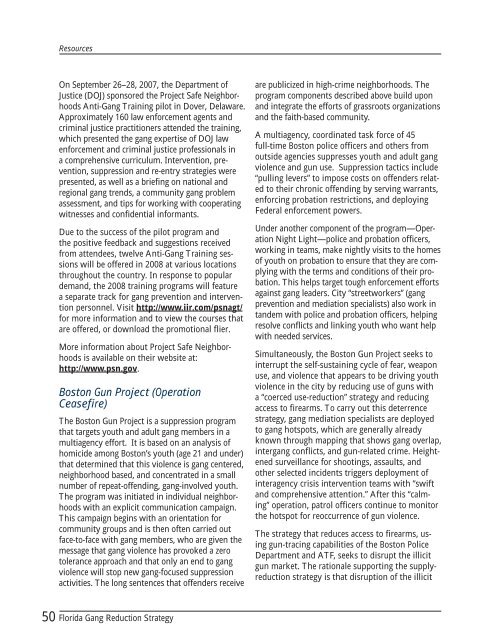Florida Gang Reduction Strategy 2008 - 2012
Florida Gang Reduction Strategy 2008 - 2012
Florida Gang Reduction Strategy 2008 - 2012
Create successful ePaper yourself
Turn your PDF publications into a flip-book with our unique Google optimized e-Paper software.
50<br />
Resources<br />
On September 26–28, 2007, the Department of<br />
Justice (DOJ) sponsored the Project Safe Neighborhoods<br />
Anti-<strong>Gang</strong> Training pilot in Dover, Delaware.<br />
Approximately 160 law enforcement agents and<br />
criminal justice practitioners attended the training,<br />
which presented the gang expertise of DOJ law<br />
enforcement and criminal justice professionals in<br />
a comprehensive curriculum. Intervention, prevention,<br />
suppression and re-entry strategies were<br />
presented, as well as a briefing on national and<br />
regional gang trends, a community gang problem<br />
assessment, and tips for working with cooperating<br />
witnesses and confidential informants.<br />
Due to the success of the pilot program and<br />
the positive feedback and suggestions received<br />
from attendees, twelve Anti-<strong>Gang</strong> Training sessions<br />
will be offered in <strong>2008</strong> at various locations<br />
throughout the country. In response to popular<br />
demand, the <strong>2008</strong> training programs will feature<br />
a separate track for gang prevention and intervention<br />
personnel. Visit http://www.iir.com/psnagt/<br />
for more information and to view the courses that<br />
are offered, or download the promotional flier.<br />
More information about Project Safe Neighborhoods<br />
is available on their website at:<br />
http://www.psn.gov.<br />
Boston Gun Project (Operation<br />
Ceasefire)<br />
The Boston Gun Project is a suppression program<br />
that targets youth and adult gang members in a<br />
multiagency effort. It is based on an analysis of<br />
homicide among Boston’s youth (age 21 and under)<br />
that determined that this violence is gang centered,<br />
neighborhood based, and concentrated in a small<br />
number of repeat-offending, gang-involved youth.<br />
The program was initiated in individual neighborhoods<br />
with an explicit communication campaign.<br />
This campaign begins with an orientation for<br />
community groups and is then often carried out<br />
face-to-face with gang members, who are given the<br />
message that gang violence has provoked a zero<br />
tolerance approach and that only an end to gang<br />
violence will stop new gang-focused suppression<br />
activities. The long sentences that offenders receive<br />
<strong>Florida</strong> <strong>Gang</strong> <strong>Reduction</strong> <strong>Strategy</strong><br />
are publicized in high-crime neighborhoods. The<br />
program components described above build upon<br />
and integrate the efforts of grassroots organizations<br />
and the faith-based community.<br />
A multiagency, coordinated task force of 45<br />
full-time Boston police officers and others from<br />
outside agencies suppresses youth and adult gang<br />
violence and gun use. Suppression tactics include<br />
“pulling levers” to impose costs on offenders related<br />
to their chronic offending by serving warrants,<br />
enforcing probation restrictions, and deploying<br />
Federal enforcement powers.<br />
Under another component of the program—Operation<br />
Night Light—police and probation officers,<br />
working in teams, make nightly visits to the homes<br />
of youth on probation to ensure that they are complying<br />
with the terms and conditions of their probation.<br />
This helps target tough enforcement efforts<br />
against gang leaders. City “streetworkers” (gang<br />
prevention and mediation specialists) also work in<br />
tandem with police and probation officers, helping<br />
resolve conflicts and linking youth who want help<br />
with needed services.<br />
Simultaneously, the Boston Gun Project seeks to<br />
interrupt the self-sustaining cycle of fear, weapon<br />
use, and violence that appears to be driving youth<br />
violence in the city by reducing use of guns with<br />
a “coerced use-reduction” strategy and reducing<br />
access to firearms. To carry out this deterrence<br />
strategy, gang mediation specialists are deployed<br />
to gang hotspots, which are generally already<br />
known through mapping that shows gang overlap,<br />
intergang conflicts, and gun-related crime. Heightened<br />
surveillance for shootings, assaults, and<br />
other selected incidents triggers deployment of<br />
interagency crisis intervention teams with “swift<br />
and comprehensive attention.” After this “calming”<br />
operation, patrol officers continue to monitor<br />
the hotspot for reoccurrence of gun violence.<br />
The strategy that reduces access to firearms, using<br />
gun-tracing capabilities of the Boston Police<br />
Department and ATF, seeks to disrupt the illicit<br />
gun market. The rationale supporting the supplyreduction<br />
strategy is that disruption of the illicit


